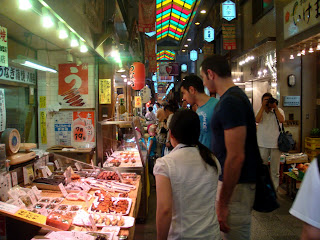This was our second day in Kyoto, and we decided to go with a tour guide, mainly for info on the locations rather than having her choose the locations herself, as we already had an itenary planned for the day. After visiting GinkaKuji, along with another temple, the Nishiki food market and Nijo castle, it was time for lunch.

The food market was an interesting experience, the most common foods, typical Kyoto specialties included pickles, tofu and agricultural produce.

Interestingly, when we were in the vicinity of Nishiki Market, a camera crew from one of the local TV channels approached us for an interview, due to our exotic appearance (in Japan at least). However, when they realized that we were not europeans, their interest in us waned somewhat. (The TV crew asked where we were from, and after I answered lebanon, they presented me with a map of europe to point out where it was.)
It was very common for random locals to come up to us and try to guess our nationality, people in Kyoto are very curious about foreigners, albeit in a very friendly manner ofcourse.




Nothing works your appetite quite as much as exploring serveral temples/castles in the span of 5-6 hours.
For this day we decided on having lunch at a place popular with the locals, rather than a high end restaurant and we went with the tour guide's choice. This was her favorite restaurant in Kyoto so we thought we would give it a shot.

The restuarant itself was a cozy, traditional, little place that seemed popular with locals (we had to wait a few minutes for a table).

The menu seemed colurful enough. Shame no english menu was available. There were two choices for main course, either deep fried chicken "Kyoto style" or Oden (Several ingredients stewed in a Dashi-Soy broth).
If someone can kindly translate the name of the restaurant from the menu (assuming that it is mentioned on there somewhere) I would be much obliged.

The meal looked extremely neat, with all the plates arranged neatly on the tray. Clockwise from top left: Enoki mushroom miso soup, Pumpkin cake dessert, Crab radish cucumber mayo salad, Deep fried chicken cutlets stuffed with a pickle relish, Nama-fu served with a sweet miso dipping sauce (wheat gluten, a high protein meat substitute popular in buddhist cuisine, and especially popular in Kyoto) and finally plain rice and pickles.
The Nama-fu was the star of the show, it was delicious! It was very chewy. The story goes that buddhist monks had got fedup with their vegetarian diets owing to the "weak" textures of vegetarian foods as opposed to meats, and they came up with this dish to mimic the chewy texture of meats.The Japanese (east asians in general actually) love their food to have chewy/unusual texture, often giving texture precedence to taste (examples are konnyaku jelly and sea cucumber among a long, long list) . Texture plays a minimal role in middle eastern cuisines, or even european cuisines, at least in the sence that no foods are valued based on texture alone.

The others ordered the above, but i opted for the more Japanese option of Oden. Although fried foods are extremely popular in Japan, and have been for a long time, they were brought to Japan by the Portuguese, and since Oden is as Japanese as it gets, my choice was obvious.
The meal was identical to the one above with the exception of the oden.
Although Oden was traditionally a winter plate, it was one of the things i had to try while in Japan. Oden is a very typical Japanese plate and is not well known outside of Japan, its ingredients appealed specifically to the Japanese palate. The contents were: Clockwise from top left, a boiled egg, konnyaku jelly (jelly made from the konjak plant) which had very little taste and was gelatinous in texture, deep fried tofu, a turnip, and a cylindrical shaped form of kamaboko. (fishcake)
The meal cost 2200 JPY (24 USD) per person. Not bad for such a filling meal. We also got a genuine taste of everyday foods that the locals eat.

I googled the name of the restaurant in the picture of the menu. I think this is probably the place:
ReplyDeletehttp://www.wachagashi.jp/kosendo/menu.html
It's called Kosendo Sumi, and from the website it should look like an old traditional Machiya from the outside.
Paul
Thats definitely the place. Thank you very much for all the help, i truly appreciate it!
ReplyDeleteGlad you are enjoying my simple blog as well.
I think this experience will help me organize my next trip.
I'm so hungry, I could eat a horse!
ReplyDelete